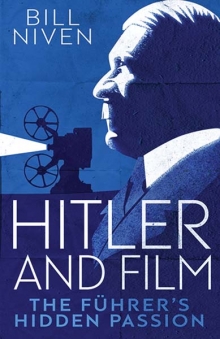Nazi Cinema
Bill Niven—
In April 1954, together with his lawyer, the film director Veit Harlan made his way to a gravel pit near Zurich. There, he demonstratively set fire to the only available negative of the anti-Semitic Nazi film he had directed for Joseph Goebbels: Jud Süβ, first shown in 1940. This was Harlan’s way of trying to dissociate himself from the film, which had, so he claimed, cost him “nine years of his life“. He was referring to the two denazification trials he had been through, as well the trial for crimes against humanity which had been opened against him in Hamburg in 1949. Harlan was exonerated. He seemed little concerned about his life before the end of the war, when he had helped through Jud Süβ to promote the Holocaust. Jud Süβ was shown to concentration camp personnel, to the SS before they went on Jew-killing sprees, to the German Army right throughout the war, and of course to regular German and non-German cinemagoers in their millions. If ever a film helped to incite violence, then it was Jud Süβ. According to Harlan, he was innocent of responsibility.
Harlan’s symbolic incineration of the negative – which he had bought for 75,000 marks to prevent new copies being made – did little to stop the illegal circulation of existing copies of Jud Süβ. The Allies had forbidden the showing in postwar Germany of a few hundred Nazi films, including Jud Süβ. While it was forbidden there, however, Arab countries were very keen to get their hands on it: Nazi anti-Semitic propaganda could now be reused as anti-Israeli propaganda. One case in particular preoccupied the German justice system: that of August Bender, a West German who had got hold of a copy of Jud Süβ and was trying to sell it to the Arabs. Following a spectacular car chase with German customs officials through Baden-Baden, Bender deposited the film with the Freiburg Finance Office, who seemed quite happy to accept it as a security against his tax debts. There followed protracted judicial attempts to wrest the film from Bender, made difficult by unclarity over ownership rights of historic film copies. All the while, Bender went on trying to sell it. Matters turned particularly scandalous when he approached a millionnaire scrapmerchant and offered him the chance to become a business partner in his dealings with cinemas in Beirut and Cairo, which, he claimed, had already signed contracts for Jud Süβ. Little did Bender suspect that the scrap merchant was none other than Werner Nachmann, a conservative politician and President of the Central Council of Jews in Germany.
Strikingly, the Federal government in Bonn did little to intervene, though it was kept well informed of the case. The Federal Prosecutor advised against criminal law proceedings, especially if initiated from his office, encouraging the continued use of civil law instead – which of course kept the whole situation away from too much media attention. The extraordinary legal procrastination and pussyfooting indicated a lack of judicial and political will to tackle the toxic legacy of Nazi films. In fact, until 1966, when the Murnau Foundation in West Germany took responsibility for administering this legacy, film companies and distributors and cinema owners had all been trying to get proscribed films taken off the blacklist. West Germany had few qualms showing Nazi-period films in cinemas and, increasingly, on TV. Even if the majority of the films shown had never been blacklisted, and were classified as “mere entertainment”, their production under Hitler’s dictatorship should have given more cause for concern. East Germany was much more cautious, although here too Nazi-period films were shown. It was not just Nazi-period films that were regarded in postwar Germany as largely untainted: the same goes for those who directed and acted in them, many of whom went on to have highly successful careers after a casual brush with the denazification authorities, to whom they pleaded innocence. Wolfgang Liebeneiner, for instance, who made the pro-euthanasia film I Accuse (1941), established himself as one of West Germany’s leading directors. Even Harlan went on directing (although when he tried to muzzle Erich Lüth, spokesman for the Hamburg Senate, for calling on Germans to boycott his films, this led to a famous judgement by the Federal Constitutional Court protecting the right to freedom of speech). In East Germany, director Arthur Maria Rabenalt, who had made films under the Nazis, enjoyed a long postwar career.
Right up to the present day, in united Germany, Nazi-period films enjoy regular outings on television – particularly Helmut Weiss’s Fire Tongs Bowl (1944), starring Heinz Rühmann, despite the fact that, for all its appearance of simple entertainment, it arguably reflects anti-modernist aspects of Nazi ideology. While many active in Nazi society were quietly rehabilitated in the 1950s, most of them did lie low: yet on screens around Germany, Third Reich actors were openly wooing viewers, in new films, or old films. It was as if they and the films they had starred in had represented a world beyond Nazism. The continuity of Nazi-period actors and films after 1945 helped viewers to deceive themselves into thinking there had been an apolitical space under Hitler – the cinema.
Still, not all Nazi-period films have been taken down from the blacklist. It is still not possible to see Jud Süβ in German cinemas, except in exceptional circumstances where there is a clear pedagogical framing. Given that the film is freely available on the internet, the continued prohibition has more to do with political symbolism than anything else: Germany’s cultural authorities do not want to be seen to be openly permitting an anti-Semitic film. Yet this ban, like the longstanding ban on publication of Hitler’s Mein Kampf, has the effect of stifling discussion around the film. Arguably, permitting it would stimulate the same kind of productive debate triggered by the Munich Institute of Contemporary History’s edition of Mein Kampf (2016). Part of that debate would have to focus on why Germany’s political authorities shied away from confronting the film’s poisonous afterlife in the 1960s, and why to this very day attempts are made to whitewash its leading actors (e.g. the TV docudrama George (2010), or the feature film Jud Süβ – Rise and Fall (2010)).
Further Reading



























